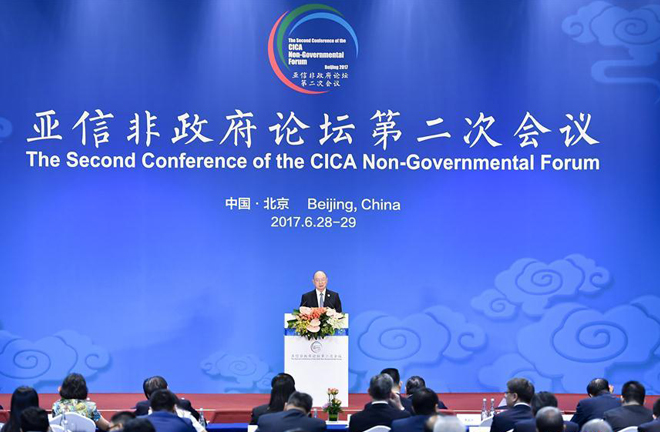CICA contributing to Asian peace, development 25 yrs on

This year marks the 25th anniversary of the Conference on Interaction and Confidence-Building Measures in Asia (CICA). Attendees to the recent Second Conference of the CICA Non-Governmental Forum stressed how the CICA mechanism promotes peace and development on the continent.
Held in Beijing, the forum gathered around 300 representatives from different parts of Asia to offer advice on regional governance.
“Had it not been for the CICA, it would be difficult for representatives from such regions as East, South and Central Asia to sit together and communicate with each other,” said Li Yongquan, director of the Institute of Russian, Eastern European and Central Asian Studies at the Chinese Academy of Social Sciences (CASS). Li emphasized that the CICA is highly inclusive and representative, saying the forum offers a crucial platform for exchange.
On the vast continent of Asia, the coexistence of diverse geographical environments, ethnic compositions, religious beliefs and ideologies has historically thwarted efforts to build a common Asian identity, and fragmentation continues to be a basic feature of the modern political landscape.
Proposed by Kazakhstan, the CICA came into being in 1992. After 25 years of development, the number of member states has increased from 16 to 26 while the amount of observers has grown to 14. It has also built partnerships with international organizations like the United Nations and the Shanghai Cooperation Organization, establishing itself as the largest, most extensive and representative security forum in Asia.
With the expansion of its “Circle of Friends,” the CICA has made progress in institutional construction. When introducing CICA’s unique models for “Confidence-Building Cooperation,” former Executive Director of the mechanism Çinar Aldemir said the CICA has defined five areas for confidence-building cooperation, including military-politics, new threats and new challenges, economy, environment, and humanities.
It has also detailed directions for cooperation in areas like combating terrorism, human smuggling and trafficking, and transnational organized crimes, Aldemir said. All member countries can offer to be a coordinating state in areas they are interested in.
“The major objective of the CICA is to promote peace while maintaining security and stability in Asia through strengthened cooperation and by multilateral means,” Aldemir said.
Since the founding of the CICA, China has been an active participant, constructor and contributor of the forum. Since 2014, the year it assumed the presidency, it has earnestly performed its responsibilities and implemented confidence-building measures in all spheres, driving the CICA into the “fast lane.”
The work China did during its presidency has won high recognition from all parties. China has displayed superior leadership, Aldemir said.
The new security concepts China advocates have also received positive responses from other Asian countries. During the CICA Shanghai Summit in 2014, Chinese President Xi Jinping called for common, comprehensive, cooperative and sustainable security in Asia.
Aldemir said that as the most representative platform for security-related dialogue in Asia, the CICA will be one of the best arenas for executing Xi’s outlook on Asian security.
Participants in the CICA non-governmental forum also discussed how to ensure the “Belt and Road” (“B&R”) initiative complements the CICA as much as possible.
Kushkumbaev Sanat, deputy director of the Kazakhstan Institute for Strategic Studies under the President of Kazakhstan, said that the “B&R” initiative is highly flexible. Whether South or Central Asia, every country can find shared interests from and align its strategies with it. The integration of the “B&R” initiative and the CICA will inject strong impetus into the latter, thereby actualizing regional prosperity and stability, Sanat said.
Building a peaceful Silk Road requires support from multilateral security cooperation platforms, said Sun Zhuangzhi, secretary-general of the SCO Research Center under CASS. He noted that the CICA is preparing to build a new framework for regional security cooperation, which will create a more favorable security environment for “B&R” construction.
Using South Asia as an example, Sudheendra Kulkarni, head of the India-based Observer Research Foundation, expressed his expectation for the simultaneous advancement of economic and security cooperation within the “B&R” framework.
South Asia is densely populated with a large number of poor people, which has hindered regional integration for a long time. Kulkarni said that the “B&R” initiative will help South Asia to improve people’s well-being and integrate multiple sub-regional economic cooperation mechanisms in South Asia to gradually propel regional integration.
MAO LI is a reporter at the Chinese Social Sciences Today.

 PRINT
PRINT CLOSE
CLOSE